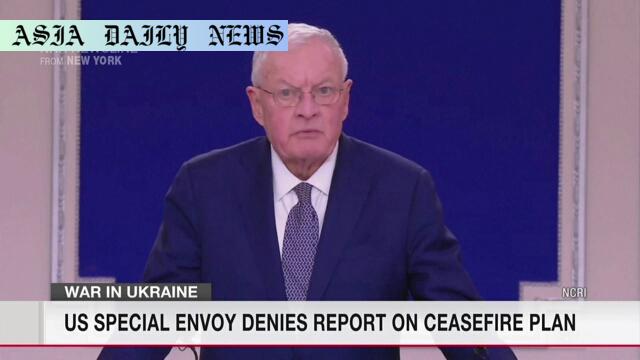Ceasefire: US Special Envoy Keith Kellogg denies reports about a peace plan for Ukraine, indicating Trump’s direct involvement.
Ceasefire: US Special Envoy Keith Kellogg denies plans reported by Bloomberg about a ceasefire initiative.
A potential freeze on conflict and ambiguous territory status were allegedly part of the rejected proposal.
Trump’s envoy highlights his intention to directly address Ukraine and Russia at prominent international forums in February.
President Zelenskyy signals that negotiating peace may be necessary despite challenges in reclaiming occupied lands.

Introduction: Clarity on the Ceasefire Rumors
Recent reports have ignited a firestorm of speculation regarding an alleged plan for a Ukraine ceasefire spearheaded by the United States. However, the Trump administration has swiftly moved to deny these claims. Keith Kellogg, the special envoy for Ukraine and Russia, unequivocally stated that the reported details of the peace proposal are inaccurate and that Trump himself will be personally taking the helm to address the ongoing crisis.
Bloomberg’s Report: The Alleged Ceasefire Proposal
Bloomberg had reported that the Trump administration was preparing a roadmap that included halting active conflict and freezing the scenario geographically, leaving Russian-held territories in an undecided state. The proposal was suggested to include measures for ensuring Ukraine’s security, which would theoretically discourage Russia from launching further attacks. While appearing to balance the scales, the plan faced criticism over its potential ambiguity, especially surrounding governance arrangements for the contested regions.
Kellogg’s Prompt Rebuttal
Keith Kellogg promptly dismissed the report during an interview with Newsmax, asserting that any comprehensive strategy for resolving the Ukraine crisis would be delivered by Trump. The envoy indicated that misleading narratives might be proliferating in international media, which could complicate ongoing diplomatic efforts. His emphasis on Trump’s direct involvement signals a more personalized approach to diplomacy.
Kellogg’s Upcoming Agenda in Europe
In February, Kellogg is scheduled to attend the Munich Security Conference aimed at fortifying Europe’s geopolitical stability amidst the ongoing crisis. He plans to use the platform to articulate Trump’s vision for peace in Ukraine and outline strategies to end hostilities. Furthermore, his planned visit to Kyiv next week will provide him with a unique opportunity to assess the situation firsthand and engage in high-level discussions with Ukrainian President Volodymyr Zelenskyy.
Zelenskyy’s Realism About the Current Dilemma
President Volodymyr Zelenskyy has acknowledged the significant challenges involved in reclaiming Russian-occupied territory by force under present conditions. While staunchly defending Ukraine’s sovereignty, Zelenskyy suggested that peace might necessitate entering negotiations with Moscow. His remarks reflect a pragmatic approach to achieving stability and an openness to exploring diplomatic alternatives, even as tensions remain high.
US, Europe, and Ukraine: A Unified but Complex Goal
The role of the United States and Europe in supporting Ukraine underscores the importance of unity in facing shared geopolitical adversities. However, balancing military aid with diplomatic initiatives continues to pose challenges. As articulated by both Kellogg and Zelenskyy, peace efforts will require nuanced engagement, with strategic gains like security assurances and potential resolutions for territorial disputes being at the core of future negotiations.
Conclusion: A Crossroads for Peace
The unfolding dynamics around the Ukraine ceasefire highlight the complexity of modern geopolitics. As the Trump administration denies media-reported plans, focus shifts to international engagements such as the Munich Security Conference, where clarity may emerge. With all eyes on the potential outcomes of Trump’s eventual proposal, any peace effort would need to navigate between political sensitivities, territorial integrity, and long-term security assurances.
Commentary
The Need for Transparency in Peace Efforts
The conflicting narratives surrounding the United States’ involvement in mediating the Ukraine crisis shed light on a critical need for transparency in diplomatic efforts. Reports from credible media outlets like Bloomberg can significantly influence public expectations and diplomatic relations. At the same time, outright denials from officials such as Keith Kellogg may counter confusion but risk leaving gaps in understanding.
The Balancing Act of Diplomacy
For any peace proposal to be truly impactful, it must address both Ukraine’s sovereignty and the practical challenges of enforcing agreements with a substantial geopolitical power like Russia. Proposals such as freezing conflicts or leaving territories in limbo might offer temporary relief but could risk longer-term instability. Diplomacy needs to be bold yet meticulous, reflecting the aspirations of those directly affected.
Optimism for Trump’s Potential Vision
As Kellogg emphasizes Trump’s direct role in any eventual plan, there is potential for a recalibration of peace strategies. Past administrations have faced immense challenges in brokering agreements in regions marred by protracted conflict. Perhaps now is an opportunity to adopt innovative approaches that boldly address core issues.
In essence, the coming weeks—marked by Kellogg’s engagements in Munich and Kyiv—could pave the way for definitive peace or further complications based on the decisions and actions taken. The global community would hope for progress, if not resolution, to one of the most destabilizing conflicts of the modern era.


